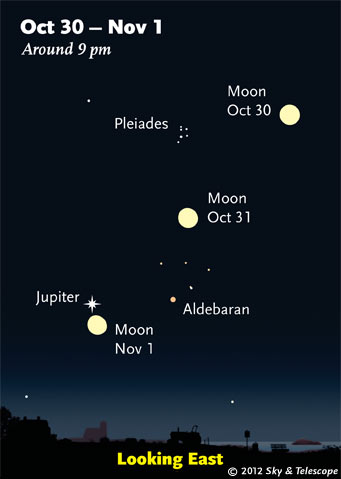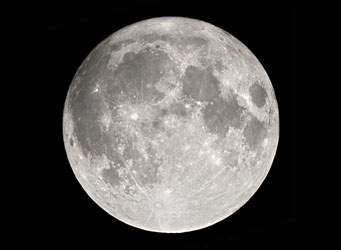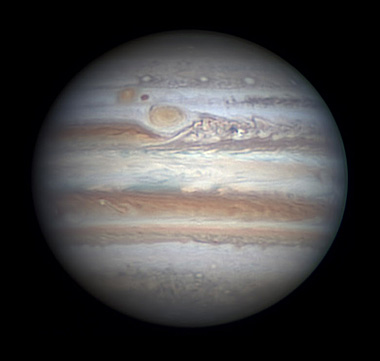
The Moon appears to pair up with Jupiter on November 1st. The Moon here is shown three times its actual apparent size, and is positioned for a viewer near the middle of North America.
Sky & Telescope diagram
Friday, October 26
Saturday, October 27
Sunday, October 28

When the Moon is full, its craters, mountains, and other surface features appear muted because the high Sun casts no shadows as seen from our earthbound perspective.
Gary Seronik
Monday, October 29
Tuesday, October 30
Wednesday, October 31
Thursday, November 1
Friday, November 2
Saturday, November 3
Want to become a better amateur astronomer? Learn your way around the constellations. They're the key to locating everything fainter and deeper to hunt with binoculars or a telescope.
For an easy-to-use constellation guide covering the whole evening sky, use the big monthly map in the center of each issue of Sky & Telescope, the essential guide to astronomy. Or download our free Getting Started in Astronomy booklet (which only has bimonthly maps).
Sky Atlas 2000.0 (the color Deluxe Edition is shown here) plots 81,312 stars to magnitude 8.5. That includes most of the stars that you can see in a good finderscope, and typically one or two stars that will fall within a 50× telescope's field of view wherever you point. About 2,700 deep-sky objects to hunt are plotted among the stars.
Alan MacRobert
Once you get a telescope, to put it to good use you'll need a detailed, large-scale sky atlas (set of charts). The standards are the little Pocket Sky Atlas, which shows stars to magnitude 7.6; the larger and deeper Sky Atlas 2000.0 (stars to magnitude 8.5); and the even larger Uranometria 2000.0 (stars to magnitude 9.75). And read how to use sky charts with a telescope effectively.
You'll also want a good deep-sky guidebook, such as Sue French's Deep-Sky Wonders collection (which includes its own charts), Sky Atlas 2000.0 Companion by Strong and Sinnott, the bigger Night Sky Observer's Guide by Kepple and Sanner, or the beloved if dated Burnham's Celestial Handbook.
Can a computerized telescope replace charts? Not for beginners, I don't think, and certainly not on mounts and tripods that are less than top-quality mechanically (able to point with better than 0.2° repeatability). As Terence Dickinson and Alan Dyer say in their invaluable Backyard Astronomer's Guide, "A full appreciation of the universe cannot come without developing the skills to find things in the sky and understanding how the sky works. This knowledge comes only by spending time under the stars with star maps in hand."
This Week's Planet Roundup

The Great Red Spot's side of Jupiter is busy indeed. On October 29th when Christopher Go shot this image from the Philippines, bright orange Oval BA and the little dark red dot following it had finished passing south of (above) the Great Red Spot. Huge turbulence roils the South Equatorial Belt behind the Great Red Spot, and in the midst of this, notice the tiny dark marking next to a bright little white outbreak.
The South Temperate Belt is barely visible along some of its length but prominent elsewhere. Four white ovals dot the South South Temperate Belt. On the north (lower) side of the planet, the North Equatorial and North Temperate belts have become cleanly separated by the North Tropical Zone's return to whiteness. An extremely wide blue festoon intrudes into the bright Equatorial Zone north of the Great Red Spot.
Mercury (magnitude –0.2) is having a poor evening apparition. Using binoculars, look for it about 30 minutes after sundown very low in the southwest, to the lower right of Mars and Antares.
Venus (magnitude –4.0, in Virgo) rises in darkness more than an hour before the first glimmer of dawn. By dawn it's shining brightly in the east.
Mars (magnitude +1.2, in Ophiuchus) remains low in the southwest in evening twilight. It's upper left of similar-looking Antares; they widen from 6° to 10° apart this week.
Jupiter (magnitude –2.7, in Taurus) rises in the east-northeast shortly after dark, with Aldebaran to its right. Above Aldebaran are the Pleiades.
Saturn is buried deep in the glow of sunrise.
Uranus (magnitude 5.8, in Pisces) and Neptune (magnitude 7.9, in Aquarius) are in in good view in the south during evening. Finder charts for Uranus and Neptune.
All descriptions that relate to your horizon — including the words up, down, right, and left — are written for the world's mid-northern latitudes. Descriptions that also depend on longitude (mainly Moon positions) are for North America. Eastern Daylight Time (EDT) equals Universal Time (also known as UT, UTC, or GMT) minus 4 hours. Eastern Standard Time is UT minus 5 hours.
Like This Week's Sky at a Glance? Have a look at our SkyWeek TV short. It's also playing on PBS!
To be sure to get the current Sky at a Glance, bookmark this URL:
http://SkyandTelescope.com/observing/ataglance?1=1
If pictures fail to load, refresh the page. If they still fail to load, change the 1 at the end of the URL to any other character and try again.
 0
0
Comments
You must be logged in to post a comment.